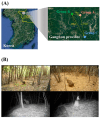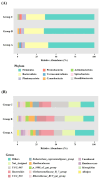Insights into the Gut Microbial Diversity of Wild Siberian Musk Deer (Moschus moschiferus) in Republic of Korea
- PMID: 39457930
- PMCID: PMC11503724
- DOI: 10.3390/ani14203000
Insights into the Gut Microbial Diversity of Wild Siberian Musk Deer (Moschus moschiferus) in Republic of Korea
Abstract
The gut microbiota plays a crucial role in the health and well-being of wildlife. However, its composition and diversity remain unexplored, particularly in threatened species such as the Siberian musk deer (SMD). This study aimed to elucidate the gut microbiota composition within different wild SMD communities for assessing their health status. We conducted the first comprehensive fecal microbiome analysis of wild SMD inhabiting three distinct locations in Gangwon Province, Republic of Korea (Korea). Fecal samples were collected non-invasively and 16S rRNA gene sequencing was performed for gut microbiota characterization. Consistent with previous research, Firmicutes and Bacteroidetes were the dominant phyla in the gut microbiota of wild SMD. Planctomycetota was a prevalent phylum in wild SMD gut microbiota, warranting further investigation of its ecological significance. While significant differences were observed in the gut microbiota richness among the three groups, no significant disparities were detected in the beta diversity. Additionally, certain genera exhibited distinct relative abundances among the groups, suggesting potential associations with geographic factors, gut disorders, and dietary habits. Our findings provide valuable insights into the gut microbiome of wild SMD and offer a foundation for future microbiome-based conservation efforts for this vulnerable species.
Keywords: 16S rRNA; Moschus moschiferus; Siberian musk deer; fecal microbiome; non-invasive; wildlife conservation.
Conflict of interest statement
The authors declare that this research was constructed in the absence of any commercial or financial relationships that could be construed as potential conflicts of interest.
Figures










Similar articles
-
First Investigation of the Spring Dietary Composition of Siberian Musk Deer (Moschus moschiferus) Using Next-Generation Sequencing.Animals (Basel). 2024 Dec 18;14(24):3662. doi: 10.3390/ani14243662. Animals (Basel). 2024. PMID: 39765566 Free PMC article.
-
Marked variations in gut microbial diversity, functions, and disease risk between wild and captive alpine musk deer.Appl Microbiol Biotechnol. 2023 Sep;107(17):5517-5529. doi: 10.1007/s00253-023-12675-1. Epub 2023 Jul 8. Appl Microbiol Biotechnol. 2023. PMID: 37421471 Free PMC article.
-
Comparative study of the function and structure of the gut microbiota in Siberian musk deer and Forest musk deer.Appl Microbiol Biotechnol. 2022 Oct;106(19-20):6799-6817. doi: 10.1007/s00253-022-12158-9. Epub 2022 Sep 14. Appl Microbiol Biotechnol. 2022. PMID: 36100751
-
Changes in Gut Microbiota Composition Associated with the Presence of Enteric Protist Blastocystis in Captive Forest Musk Deer (Moschus Berezovskii).Microbiol Spectr. 2022 Aug 31;10(4):e0226921. doi: 10.1128/spectrum.02269-21. Epub 2022 Jun 23. Microbiol Spectr. 2022. PMID: 35736237 Free PMC article.
-
Environmental factors and gut microbiota: Toward better conservation of deer species.Front Microbiol. 2023 Mar 7;14:1136413. doi: 10.3389/fmicb.2023.1136413. eCollection 2023. Front Microbiol. 2023. PMID: 36960286 Free PMC article. Review.
References
-
- Tsendjav D. Mongolian Musk Deer (Moschus moschiferus Linnaeus, 1758) Jinst Cargana Co., Ltd.; Ulaanbaatar, Mongolia: 2002.
-
- Cai Y., Yang J., Wang J., Yang Y., Fu W., Zheng C., Cheng J., Zeng Y., Zhang Y., Xu L., et al. Changes in the Population Genetic Structure of Captive Forest Musk Deer (Moschus berezovskii) with the Increasing Number of Generation under Closed Breeding Conditions. Animals. 2020;10:255. doi: 10.3390/ani10020255. - DOI - PMC - PubMed
-
- Lee W.S., Rhim S.J. Changes in distribution area of Korean musk deer (Moschus moschiferus parvipes) from 1950s to 1999 in South Korea. J. For. Res. 2002;13:135–136. doi: 10.1007/BF02857238. - DOI
-
- Woo H.C. The report of the rare and endangered species of mammals in Korea. Bull Korean Assoc. Conserv. Nat. 1990;10:5–27.
Grants and funding
LinkOut - more resources
Full Text Sources

